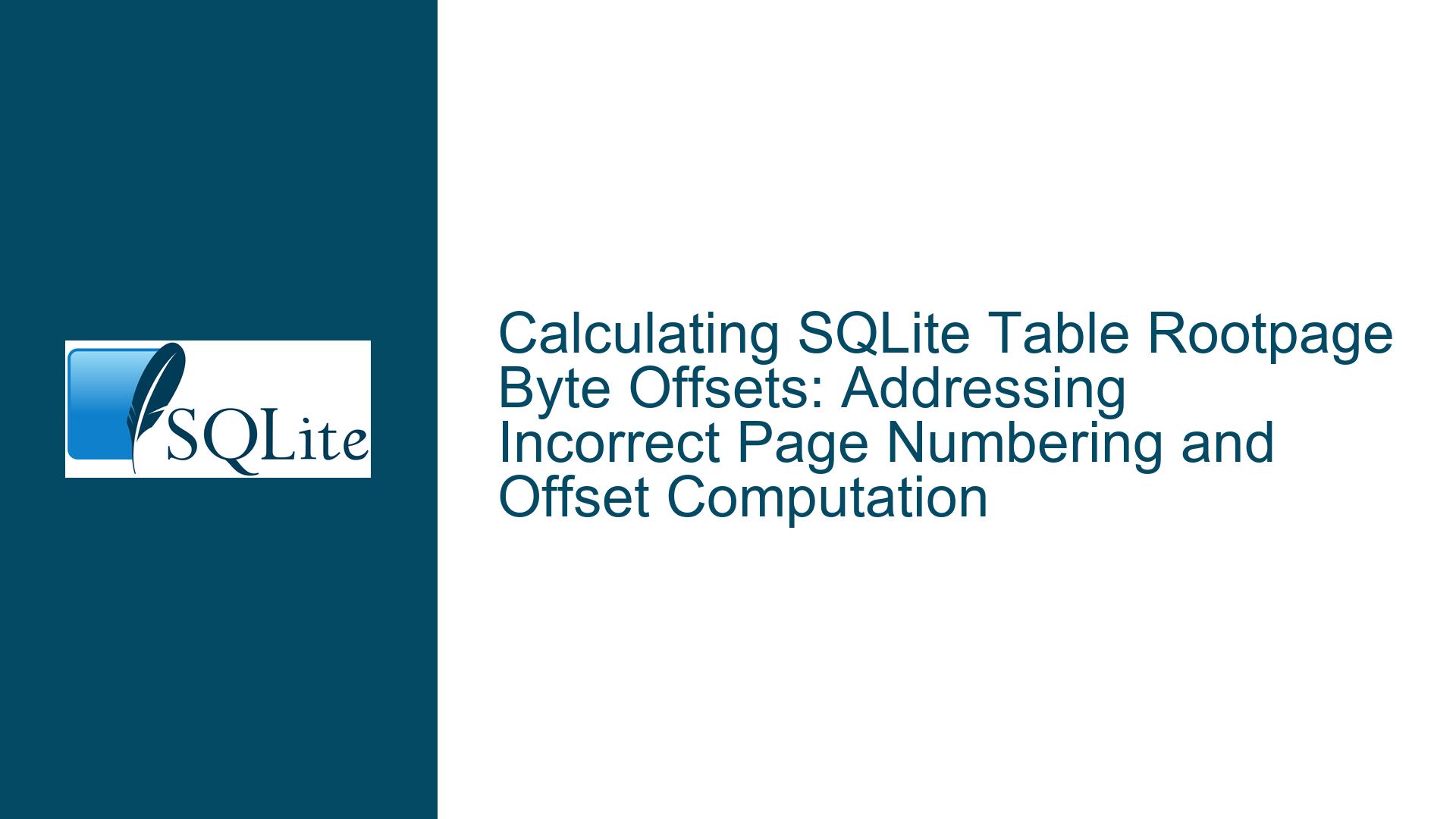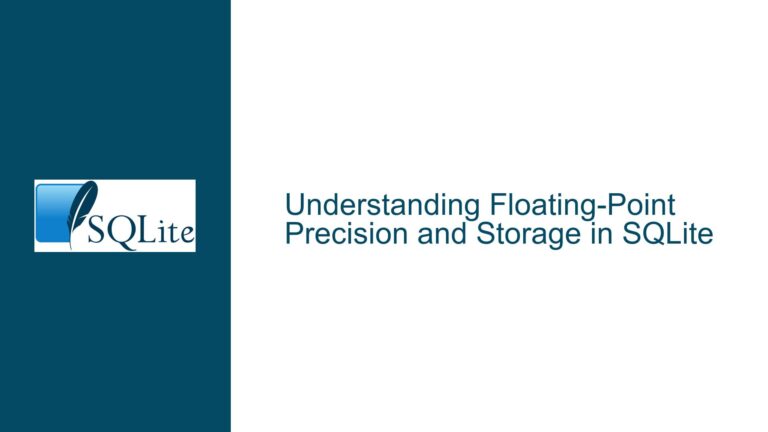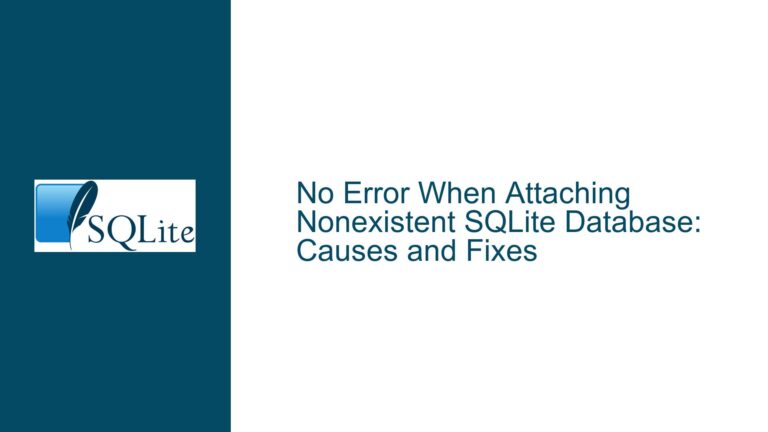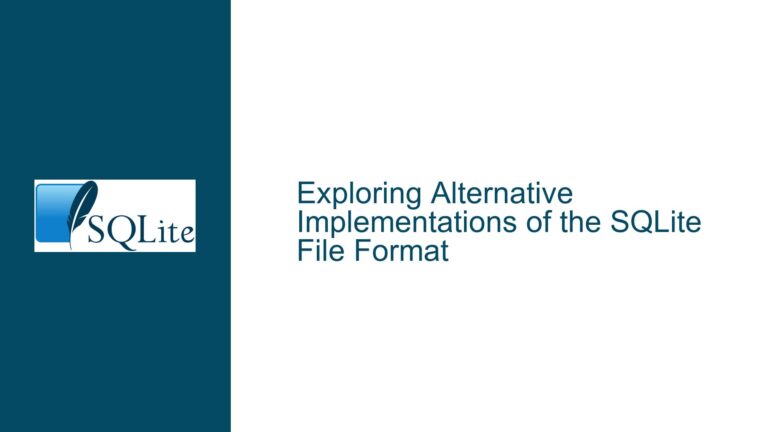Calculating SQLite Table Rootpage Byte Offsets: Addressing Incorrect Page Numbering and Offset Computation
Issue Overview: Misalignment Between Rootpage Number and Physical Byte Offset in SQLite Database File
The core challenge revolves around accurately determining the physical byte offset of a table’s rootpage within an SQLite database file when working with low-level file operations. Developers attempting direct file manipulation for corruption testing or recovery simulations often encounter discrepancies between the rootpage number reported in the sqlite_master table and the actual byte position in the database file. This mismatch arises from fundamental misunderstandings of SQLite’s page numbering system and file structure conventions.
SQLite organizes database files into fixed-size pages, with the first page (page 1) containing the 100-byte database header followed by schema information. Each subsequent page starts at an offset calculated as (page_number - 1) * pagesize. The sqlite_master table’s rootpage column stores the 1-based page number where a table’s B-tree structure begins. Common errors occur when developers either treat this rootpage number as 0-indexed or fail to account for the header’s presence within page 1.
This issue becomes particularly critical when implementing database corruption testing workflows, where precise byte-level manipulation is required to target specific tables without affecting others. The complexity increases when dealing with Write-Ahead Logging (WAL) mode, though in this specific scenario, the WAL file has been properly checkpointed and transactions concluded, eliminating WAL-related interference.
Possible Causes: Page Number Indexing Errors and Header Space Miscalculations
Three primary factors contribute to miscalculations of rootpage byte offsets:
1-Based Page Numbering Misinterpretation: SQLite uses 1-based indexing for page numbers, where page 1 contains the database header followed by schema details. Developers accustomed to 0-based array indexing might incorrectly compute the offset as
pagesize * rootpageinstead ofpagesize * (rootpage - 1).Header Space Allocation Oversight: The first 100 bytes of page 1 are reserved for the database header, meaning the actual user data starts at byte 100 within page 1. However, this header space only exists in page 1 – subsequent pages start immediately at their computed offset without additional headers. Confusion arises when developers either:
- Apply the 100-byte header offset to all pages
- Fail to recognize that page 1 contains both header and schema data
- Mistakenly add 100 bytes to offsets for non-page-1 rootpages
Pagesize Determination Errors: The database page size is stored as a 2-byte big-endian integer at offset 16 in the database header. Incorrectly reading this value (e.g., using little-endian interpretation) or assuming a default 4096-byte pagesize without verification leads to faulty offset calculations. This is exacerbated when working with databases created with non-standard page sizes (e.g., 8192 or 32768 bytes).
Troubleshooting Steps: Validating Page Calculations Through Header Inspection and Binary Analysis
Step 1: Confirm Database Configuration Parameters
Extract the page size from the database header using a hex editor or binary file reader:
- Open the .db file in a hex editor
- Navigate to byte offset 16 (0x10 in hex)
- Read the next two bytes as big-endian unsigned integer
- Example: Bytes
00 10represent 4096-byte pages - Bytes
20 00represent 8192 bytes (0x2000 in big-endian)
- Example: Bytes
Validate using SQLite CLI:
PRAGMA page_size; -- Returns configured page size
PRAGMA page_count; -- Verifies total pages match file size
Step 2: Compute Physical Offsets Using Correct Page Indexing
For a rootpage number N and pagesize P:
- Byte offset = P * (N – 1)
Example calculation:
- Pagesize = 4096
- Rootpage = 167
- Offset = 4096 * (167 – 1) = 4096 * 166 = 679,936
Critical verification steps:
- For rootpage = 1: Offset 0 (contains header + schema)
- For rootpage = 2: Offset 4096 (first data page)
- Use
ls -l database.dbto confirm file size >= offset + pagesize
Step 3: Inspect Target Page Contents Using Hex Dump
At calculated offset 679,936 (from previous example):
- Hex dump 40 bytes for initial inspection:
dd if=database.db bs=1 skip=679936 count=40 | hexdump -C - Validate page header signature:
- Byte 0: Page type (0x0D for leaf table B-tree, 0x05 for interior)
- Bytes 1-2: First free block offset (big-endian)
- Bytes 3-4: Cell count (big-endian)
- Bytes 5-8: Rightmost child page (interior pages only)
Step 4: Cross-Validate Using SQLite Diagnostic Tools
Use
sqlite3_analyzertool:sqlite3_analyzer database.db > analysis.txtSearch output for "Page 167:" to confirm page type and contents
Enable SQLite debugging output:
sqlite3_db_config(db, SQLITE_DBCONFIG_ENABLE_QPSG, 1, 0); // Enable query planner stability EXPLAIN QUERY PLAN SELECT * FROM myTable; // Verify accessed rootpage
Step 5: Implement Corruption Testing Safeguards
When deliberately corrupting pages for recovery testing:
- Always create backup copies before modification
- For table-specific targeting:
- Corrupt only the calculated page range
- Leave sqlite_master (page 1) and other system tables intact
- Use checksum validation:
sqlite3 database.db "PRAGMA integrity_check;" - Consider using the SQLite Encryption Extension (SEE) to test encrypted database corruption scenarios
Final Implementation Checklist for Reliable Offset Calculation:
- [ ] Confirmed pagesize via both PRAGMA and binary header inspection
- [ ] Verified WAL file is checkpointed and removed (journal_mode=DELETE)
- [ ] Computed offset as (rootpage – 1) * pagesize
- [ ] Validated page header matches expected B-tree type
- [ ] Checked adjacent pages to ensure no overflow page dependencies
- [ ] Tested corruption/recovery cycle on non-critical database copy
By methodically applying these steps, developers can achieve precise control over SQLite storage layer manipulation while avoiding common pitfalls in page offset calculation. This technical deep dive into SQLite’s file format conventions provides the foundation for advanced database engineering tasks requiring direct file access and low-level data structure manipulation.






